I normally have a dream bike commute. My eight mile early morning trip into the office is a mere 200 foot gain in elevation. When I get to work, the showers at my gym are less than a hundred paces from the secure, locked conference room where I park my bike. When I head home in the afternoon, my sedate route downhill runs through the shade provided by the noise abatement wall of a freeway and the trees of quiet neighborhoods.
I could probably do the trip, either way, in less than 45 minutes, but it is such an enjoyable ride that it invariably takes me a relaxing hour or more.
For my wife, however, it is a different story. Her trip to work is a nerve wracking 15 miles of busy surface streets and high-speed freeways. If she were to go by bike, the roundabout route she would have to take would probably be greater than 20 miles.
She will never bike commute, not only because the distance challenge would be much greater, but also because she has a thing about getting into accidents with any wheeled vehicle she operates. None of the accidents she has had have been her fault, she just seems to attract collisions.
Suspecting that my wife’s commute was more typical than mine, I performed a brief search online for commuting statistics. Sure enough, I found two studies which indicated the typical Phoenix commute was about 12.5 miles.
One was by The Center for Neighborhood Technology, in cooperation with Virginia Tech; the other was the USDOT Federal Highway Administration 2009 National Household Travel Survey – Summary of Travel Trends. (Congratulations, Ted! With your new 12.4-mile Tucson commute, you’re now much closer to typical!)
Feeling guilty about my commute of an Easy Eight, I decided I needed to bolster my credibility as a bike commuting advocate by taking on a much more challenging mock ride to work:
I would, for one day at least, ride a more typical route of around 12.5 miles into the center of the city, and I would combine bus and train public transportation to be The Multimoding Cat.
With a Monday off of my real work, my experiment would be much more of a real life experience. And I timed my trip for the peak of rush hour to make it even more real. I hopped aboard my grocery-getter — my Specialized Hardrock — just before 7:15 AM and headed out.
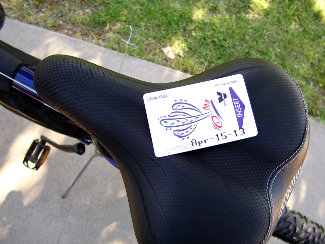
First, I needed a transit pass. Valley Metro, the nonprofit public corporation which runs the bus and light rail services in the Phoenix metro area, sells tickets at a number of retail businesses in town, including select grocery stores, convenience stores and drug stores.
I rode over to a drug store and purchased an All-Day pass for $4.00. The pass allows the rider to board any bus (except for express buses) or light rail train, and unlimited transfers for the day. Metro has discount 7-, 15- and 31-day passes available that can reduce the per-day cost down to as little as $2.06; they also have discounted passes for senior citizens and kids under 19-years-old.
With my pass tucked safely into my sling bag, I coasted across a parking lot to a bus stop. A bus pulled up less than a minute later. The city buses have a fold-down rack in the front which will hold two bicycles. There was already a bike in the rear pair of wheel slots, so I wrestled the Hardrock into the front pair. It was a pretty tight fit, but I got it in and put the restraining hook up over the front wheel.

I boarded the bus and put my transit pass in the little slot. It gobbled it up, spit it back out and I was allowed to get behind the yellow line. No seats were open, but that was okay because I wanted to talk to the driver. She reminded me of Conchata Ferrell, the gal who plays the tough, razor witted housekeeper Berta on Two and a Half Men.
I got that impression when she had to jump out of the driver’s seat at the very next stop and help a fellow in a powered wheelchair get off. She traded jabs with him, and some of the other passengers, with the skill of a practiced stand-up comic. When she got back to her seat, she called out “Hey! Biker! I thought I told you to get that hook back up on your bike.”
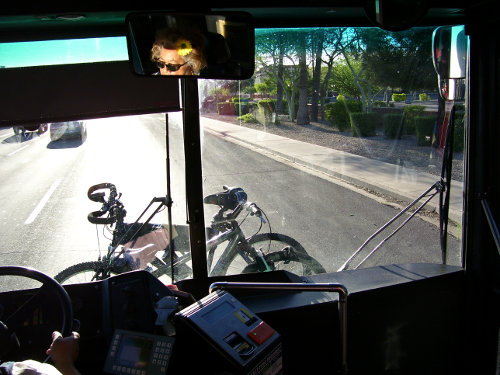
I looked back behind me, didn’t see anybody moving, turned back around and said “Wait, you mean me?”
“Yeah,” she said.
I hustled down the stairs and saw, sure enough, that the hook had flopped off of the wheel. I flipped it back up, and this time I jammed it over the top of the left fork shock. When I got back on the bus, Berta said “That’s what you get for having those big, thick wheels.”
“I think that slot is bent,” I groused.
“Honey,” she laughed, “They’re all bent!”
We rode for a bit, and then I asked “I’m researching an article I’m writing about combining bicycling with public transportation. Have you seen an increase in bicyclists riding your bus lately?”
She thought a bit, and then replied “Yes, I definitely have.” Then her mouth twisted into a wicked little half smile and she added “Especially these guys who bring their mountain bikes with the big wide tires that they can hardly fit into the rack!”
Ouch. She was good. Admonishment taken: bus bikers should probably equip their rides with skinny road tires.
I got off about a half mile later, because Berta was continuing east and I needed to head south. A couple of people were waiting at the bus stop. I looked north and did not see a bus coming. This gave me an opportunity to test a theory I have: a guy on a bike can beat a city bus in a race. I took off south, not riding much over my typical sidewalk speed of 8 mph.
I rode slightly over two miles to the light rail station and never even saw a bus in my rear-view mirror, but I don’t think it is a matter of the bus being really slow. The buses are scheduled for every half hour, and I think I started out pretty close to 15 minutes between buses. Valley Metro’s estimated time for the bus on that route is right around 12 minutes (averaging about 11 mph). I made the trip in about 13 minutes (approximately a 10 mph average). Even though the bus probably was going slightly faster than me, it wasn’t going fast enough to get within sight of me by the time I got to the light rail station.
I arrived at the station about five minutes before the train arrived. The Valley Metro light rail trains all have a car with four hooks for bicycles; two on the left side at the front of the car, and two at the right rear. You hoist the bike up vertically and place the front wheel on the hook.
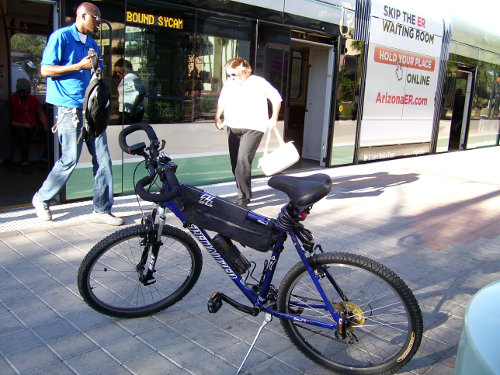
Although my aluminum framed mountain bike is not really heavy, it was quite a struggle getting the bike up to that hook (it looked to be around six feet off t
he floor of the car). I almost fell down when the train started moving before I had the bike in place. A fellow in the seat behind me helped me by grabbing the rear wheel and giving a shove. When I sat down and thanked him, I learned that it was his road bike with the aerobars hanging next to my bike. My helper said he rides the light rail every workday from Mesa to downtown Phoenix, a distance of about 16 miles. He assured me that I shouldn’t worry about scratching his bike, and that everybody struggles getting their bikes up there.
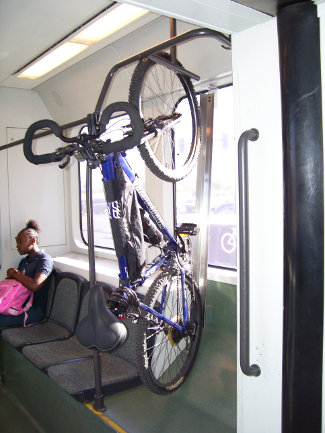
We chatted a bit more before we came to his stop. I returned the favor for him by swinging my bike out of the way so he could get his down more easily. After that, until we got to my stop, there wasn’t anybody who looked like they were amenable to conversation. A high school kid sitting next to me was dozing with his chin all the way down on his chest. A big fellow with his hair tied back in a pony tail, and a silver ring in each nostril, was lost in a paperback book. All of the rest of the passengers who got on and got off were engrossed in their own reading material or smart phones.
At the stop before mine, I got a jump on the departing process by retrieving my bike from the hook; I didn’t want to be struggling with the bike when we rolled into my station.
After exiting the train, I parked the bike and did some quick calculations. The entire trip, from boarding the bus to this train station, was a distance of almost 13.5 miles. I had made the trip in about an hour and ten minutes, so my average speed was really close to 11.5 mph. Not bad at all, considering my typical average speed on my real morning commute is right at 12 mph; on the downhill trek in the afternoon, even with the heavy traffic, I average about 14 mph.
I moved over to the platform for trains headed back the way I had come. When I boarded the return train, I didn’t put the bike up on a rack hook because all of them were taken. There were an additional three bicycles in the aisles.
Unlike the bus, which requires you to wait for the next bus if the rack on the front is full, if all of the light rail bike hooks are filled you can stand with your bicycle to one side of the larger aisles. It does require you to jockey your bike around to make room for people entering and leaving. At one point, some riders left a three-seat unit just in front of me and it automatically flipped up out of the way to become a wheelchair space. Since there weren’t any wheelchairs needing it, I rolled my bike into it and was well out of the way.
One thing I needed to do was keep a light grip on the bike brake. As the train started and stopped, my bike would tend to roll backward and forward, and if I didn’t keep a grip the bike would try to get away from me.
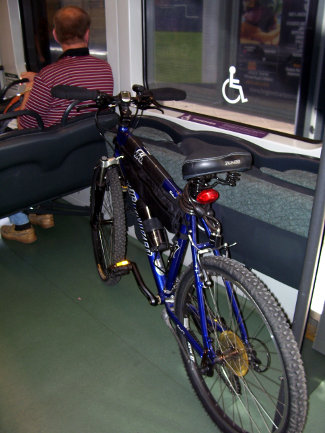
I left the train at a station closer to my house, and rode the bike straight home at my usual commuting speed. A check of the return trip ride statistics were remarkable similar: I had gone a distance of right at 11.5 miles in just under an hour, so my average speed was again around 11.5 mph.
I don’t think my brief experiment with multimode commuting allows me to make any broad statements about it, but I can make a few observations, at least about how it would work in Phoenix.
- I wouldn’t bring any panniers or other rack-mounted bags, for a number of reasons: (1) You’ll have to remove them and take them with you on the bus, because they do not allow you to leave them mounted to the bike on the rack; (2) It’ll be almost impossible to heft the bike up onto the train car hook because there isn’t room and the bike will be way too heavy; (3) While standing with your bike in the train aisle, your hand will get extremely tired as you keep pressure on the brake; (4) It will be much more difficult to move your bike out of the way so other passengers can enter and leave.
- Equip your bike with narrow tires, so you won’t be scolded by Berta.
- An ideal bicycle for multimoding might be a fixie: light enough to move around in the train aisle, to put up on the hook and to not fly out of your hands when the train comes to a quick stop.
 BluesCat is a resident of Phoenix, Arizona, who originally returned to bicycling in 2002 in order to help his son get the Boy Scout Cycling merit badge. His bikes sat idle until the summer of 2008 when gas prices spiked at over $4.00 per gallon. Since then, he has become active cycling, day-touring, commuting by bike, blogging (azbluescat.blogspot.com) and giving grief to the forum editors in the on-line cycling community.
BluesCat is a resident of Phoenix, Arizona, who originally returned to bicycling in 2002 in order to help his son get the Boy Scout Cycling merit badge. His bikes sat idle until the summer of 2008 when gas prices spiked at over $4.00 per gallon. Since then, he has become active cycling, day-touring, commuting by bike, blogging (azbluescat.blogspot.com) and giving grief to the forum editors in the on-line cycling community.